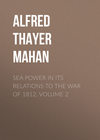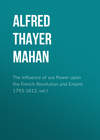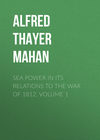Buch lesen: «The Major Operations of the Navies in the War of American Independence», Seite 12
On July 2d Arbuthnot had sailed for England, leaving the command at New York to Rear-Admiral Thomas Graves. Graves on the same day wrote to Rodney by the brig Active, that intercepted dispatches of the enemy had revealed that a large division from the West Indies was to arrive on the American coast during the summer, to coöperate with the force already in Newport. Rodney, on the other hand, dispatched to New York on July 7th the Swallow sloop, 16, with word that, if he sent reinforcements from the West Indies, they would be ordered to make the Capes of the Chesapeake, and to coast thence to New York. He asked, therefore, that cruisers with information might be stationed along that route. Two days later, having then certain news that de Grasse had sailed for Cap François, he sent this intelligence to Sir Peter Parker at Jamaica, and gave Sir Samuel Hood preparatory orders to command a reinforcement of ships destined for the continent. This, however, was limited in numbers to fifteen sail of the line, Rodney being misled by his intelligence, which gave fourteen ships as the size of the French division having the same destination, and reported that de Grasse himself would convoy the trade from Cap François to France. On the 24th instructions were issued for Hood to proceed on this duty. He was first to convoy the trade from Jamaica as far as the passage between Cuba and Haïti, and thence to make the utmost speed to the Chesapeake. A false rumour, of French ships reaching Martinique from Europe, slightly delayed this movement. The convoy was dispatched to Jamaica with two ships of the line, which Sir Peter Parker was directed to send at once to America, and requested to reinforce with others from his own squadron. Hood was detained until the rumour could be verified. On the 1st of August Rodney sailed for England on leave of absence. On the 10th Hood left Antigua with fourteen ships of the line, direct for the Capes. He had already received, on August 3d, Graves's letter by the Active, which he sent back on the 8th with his answers and with a notification of his speedy departure.
The Swallow and the Active should have reached Graves before Hood; but neither got to him at all. The Swallow arrived safely in New York on the 27th of July; but Graves had sailed with all his squadron on the 21st, for Boston Bay, hoping there to intercept an expected convoy from France, concerning which a special caution had been sent him by the Admiralty. The Swallow was at once sent on by the senior naval officer at New York, but was attacked by hostile vessels, forced ashore on Long Island, and lost. The Active was captured before she reached New York. Graves, thus uninformed of the momentous crisis at hand, continued cruising until the 16th of August, when he returned to Sandy Hook. There he found the duplicates of the Swallow's letters, but they only notified him of the course a reinforcement would take, not that Hood had started. On August 25th the latter, being then off the Chesapeake, sent duplicates of the Active's dispatches, but these preceded by little his own arrival on the 28th. That evening news was received in New York that de Barras had sailed from Newport on the 25th, with his whole division. Hood anchored outside the Hook, where Graves, who was senior to him, undertook to join at once. On the 31st five sail of the line and a 50-gun ship, all that could be got ready in time, crossed the bar, and the entire body of nineteen ships of the line started at once for the Chesapeake, whither it was understood now that both the French fleet and the united armies of Washington and Rochambeau were hurrying.
Count de Grasse upon his arrival at Cap François had found that many things must be done before he could sail for the continent. Measures needed to be taken for the security of Haïti; and a large sum of money, with a considerable reinforcement of troops, was required to insure the success of the projected operation, for which but a short time was allowed, as it was now August and he must be again in the West Indies in October. It was not the least among the fortunate concurrences for the American cause at that moment, that de Grasse, whose military capacity was not conspicuous, showed then a remarkable energy, politic tact, and breadth of view. He decided to take with him every ship he could command, postponing the sailing of the convoys; and by dexterous arrangement with the Spaniards he contrived to secure both the funds required and an efficient corps of thirty-three hundred French troops, without stripping Haïti too closely. On the 5th of August he left Cap François, with twenty-eight ships of the line, taking the route through the Old Bahama Channel,95 and anchored in Lynnhaven Bay, just within the entrance of the Chesapeake, on the 30th, the day before Graves sailed from New York for the same place. The troops were landed instantly on the south side of the James River, and soon reached La Fayette, who commanded the forces so far opposed to Cornwallis, which were thus raised to eight thousand men. At the same time Washington, having thrown Clinton off his guard, was crossing the Delaware on his way south, with six thousand regular troops, two thousand American and four thousand French, to join La Fayette. French cruisers took position in the James River, to prevent Cornwallis from crossing, and escaping to the southward into Carolina. Others were sent to close the mouth of the York. By these detachments the main fleet was reduced to twenty-four sail of the line.
On the 5th of September, at 8 A.M., the French look-out frigate, cruising outside Cape Henry, made the signal for a fleet steering for the Bay. It was hoped at first that this was de Barras's squadron from Newport, known to be on its way, but it was soon evident from the numbers that it must be an enemy. The forces now about to be opposed, nineteen. British sail of the line to twenty-four French, were constituted as follows: British, two 98's (three-deckers); twelve 74's, one 70, four 64's, besides frigates; French, one 104 (three-decker),96 three 80's, seventeen 74's, three 64's.
The mouth of the Chesapeake is about ten miles wide, from Cape Charles on the north to Cape Henry on the south. The main channel is between the latter and a shoal, three miles to the northward, called the Middle Ground. The British fleet, when the French were first seen from it, was steering south-west for the entrance, under foresails and topgallant sails, and it so continued, forming line as it approached. The wind was north-north-east. At noon the ebb-tide made, and the French began to get under way, but many of their ships had to make several tacks to clear Cape Henry. Their line was consequently late in forming, and was by no means regular or closed as they got outside.
At 1 P.M. Graves made the signal to form column on an east and west line, which with the wind as it was would be the close-hauled line heading out to sea, on the other tack from that on which his fleet still was. In this order he continued to head in for the entrance. At 2 P.M. the French van, standing out, three miles distant by estimate, bore south from the London, Graves's flagship, and was therefore abreast of the centre of the British line. As the British van came near the Middle Ground, at 2.13 P.M., the ships wore together. This put them on the same tack as the French, Hood's division, which had been leading, being now the rear in the reversed order. The fleet then brought-to,—stopped,—in order to allow the centre of the enemy to come abreast of the centre of the British (aa, aa.) The two lines now were nearly parallel, but the British, being five ships fewer, naturally did not extend so far as the rear of the French, which in fact was not yet clear of the Cape. At 2.30 Graves made the signal for the van ship (the Shrewsbury), to lead more to starboard (l)—towards the enemy. As each ship in succession would take her course to follow the leader, the effect of this was to put the British on a line inclined to that of the enemy, the van nearest, and as the signal was renewed three quarters of an hour later,—at 3.17,—this angle became still more marked (bb).97 This was the original and enduring cause of a lamentable failure by which seven of the rear ships, in an inferior force undertaking to attack, never came into battle at all. At 3.34 the van was ordered again to keep still more toward the enemy.

Graves and De Grasse, September 5, 1781
At 3.46 the signal was made for ships to close to one cable, followed almost immediately by that to bear down and engage the enemy,—the signal for the line still flying. Graves's flagship, the London, 98 (f), which was hove-to, filled and bore down. Under the conditions, the van ships of course got first under fire, and the action gradually extended from them to the twelfth in the order, two ships astern of the London. According to the log of the latter, at 4.11 the signal for the line ahead was hauled down, that it might not interfere with that for close action, but at 4.22 it was rehoisted, "the ships not being sufficiently extended." The meaning of this expression may be inferred from Beatson's account:—
"The London, by taking the lead, had advanced farther towards the enemy than some of the ships stationed immediately ahead of her in the line of battle; and upon luffing up (f') to bring her broadside to bear, they having done the same thing, her second ahead (m) was brought nearly upon her weather beam. The other ships ahead of her were likewise too much crowded together."
As the ship on the London's weather beam could not fire upon the enemy unless she drew ahead, this condition probably accounts for the flagship being again hove-to, while firing, as Hood says that she was. The signal for the line was hauled down again at 4.27, by the London's log, that for close action being up, and repeated at 5.20, when Hood (h) at last bore down with his division (h'), but the French ships bearing up also, he did not near them. Firing ceased shortly after sunset. The loss of the British was 90 killed, 246 wounded; that of the French is given only in round numbers, as about 200 killed and wounded.
Hood's statement introduces certain important qualifications into the above account:—
"Our centre began to engage at the same time as the van, at four, but at a most improper distance, and our rear, being barely within random shot, did not fire while the signal for the line was flying. The London had the signal for close action flying, as well as the signal for the line ahead at half a cable was under her topsails, with the main topsail to the mast,98 though the enemy's ships were pushing on."
As showing the improper distance at which the London brought-to to fire, he says:—
"The second ship astern of her (of the London) received but trifling damage, and the third astern of her received no damage at all, which most clearly proves [at] how much too great a distance was the centre division engaged."
The day after the action Hood made a memorandum of his criticisms upon it, which has been published. The gist of this is as follows. As the French stood out, their line was not regular or connected. The van was much separated from the centre and rear, and it appears also, from the French narratives, that it was to windward of the rest of the fleet. From these causes it was much exposed to be attacked unsupported. There was, by Hood's estimate, "a full hour and a half to have engaged it before any of the rear could have come up." The line of battle on the port tack, with the then wind, was east and west, and Graves had first ranged his fleet on it, as the French were doing; but afterwards, owing to his method of approach, by the van bearing down and the other ships following in its wake, the two lines, instead of being parallel, formed an angle, the British centre and rear being much more distant from the enemy than the van was. This alone would cause the ships to come into battle successively instead of together, a fault of itself; but the Commander-in-Chief, according to Hood, committed the further mistake that he kept the signal for the line of battle flying until 5.30 P.M., near to sunset. In Hood's understanding, while that signal flew the position of each ship was determined by that of Graves's flagship. None could go closer than the line through her parallel to the enemy. Hence Hood's criticism, which is marked by much acerbity towards his superior, but does not betray any consciousness that he himself needed any justification for his division not having taken part.
"Had the centre gone to the support of the van, and the signal for the line been hauled down, or the Commander-in-Chief had set the example of close action, even with the signal for the line flying, the van of the enemy must have been cut to pieces, and the rear division of the British fleet would have been opposed to those ships the centre division fired at, and at the proper distance for engaging, or the Rear-Admiral who commanded it99 would have a great deal to answer for."100
So much for the tactical failure of that day. The question remained what next was to be done. Graves contemplated renewing the action, but early in the night was informed that several of the van ships were too crippled to permit this. He held his ground, however, in sight of the French, until dark on the 9th, when they were seen for the last time. They were then under a cloud of sail, and on the morning of the 10th had disappeared. From their actions during this interval, Hood had inferred that de Grasse meant to get back into the Chesapeake without further fighting; and he implies that he advised Graves to anticipate the enemy in so doing. Though some ships were crippled aloft, the British batteries were practically intact, nor had men enough been disabled to prevent any gun in the fleet from being fought. Could but a single working day be gained in taking up an anchorage, a defensive order could be assumed, practically impregnable to the enemy, covering Cornwallis, and not impossibly intercepting the French ships left in the Bay. In the case of many men such comment might be dismissed as the idle talk of the captious fault-finder, always to the fore in life; but in the case of Hood it must be received with deference, for, but a few months later, when confronted with greater odds, he himself did the very thing he here recommended, for an object less vital than the relief of Cornwallis. Having regard to the character of de Grasse, it is reasonable to believe that, if he had found the British fleet thus drawn up at anchor in Chesapeake Bay, as he found Hood at St. Kitts in the following January, he would have waited off the entrance for de Barras, and then have gone to sea, leaving Washington and Rochambeau to look at Cornwallis slipping out of their grasp.
On the 10th of September Graves decided to burn the Terrible, 74, which had been, kept afloat with difficulty since the action. This done, the fleet stood towards the Chesapeake, a frigate going ahead to reconnoitre. On the 13th, at 6 A.M., Graves wrote to Hood that the look-outs reported the French at anchor above the Horse Shoe (shoal) in the Chesapeake, and desired his opinion what to do with the fleet. To this Hood sent the comforting reply that it was no more than what he had expected, as the press of sail the (French) fleet carried on the 9th, and on the night of the 8th, made it very clear to him what de Grasse's intentions were. He "would be very glad to send an opinion, but he really knows not what to say in the truly lamentable state [to which] we have brought ourselves."101 On the 10th de Barras had reached the Bay, where he was joined by de Grasse on the 11th, so that there were then present thirty-six French ships of the line. Graves, therefore, returned to New York, reaching Sandy Hook September 19th. On the 14th Washington had arrived before Yorktown, where he took the chief command; and the armies closed in upon Cornwallis by land as the French fleets had done already by water. On the 19th of October the British force was compelled to surrender, seven thousand two hundred and forty-seven troops and eight hundred and forty seamen laying down their arms. During the siege the latter had served in the works, the batteries of which were largely composed of ships' guns.
After Graves's return to New York, Rear-Admiral the Hon. Robert Digby arrived from England on the 24th of September, to take command of the station in Arbuthnot's place. He brought with him three ships of the line; and the two which Sir Peter Parker had been ordered by Rodney to send on at once had also reached the port. It was decided by the land and sea officers concerned to attempt the relief of Cornwallis, and that it was expedient for Graves to remain in command until after this expedition. He could not start, however, until the 18th of October, by which time Cornwallis's fate was decided. Graves then departed for Jamaica to supersede Sir Peter Parker. On the 11th of November Hood sailed from Sandy Hook with eighteen ships of the line, and on the 5th of December anchored at Barbados. On the 5th of November de Grasse also quitted the continent with his whole fleet, and returned to the West Indies.
CHAPTER XI
NAVAL EVENTS OF 1781 IN EUROPE. DARBY'S RELIEF OF GIBRALTAR, AND THE BATTLE OF THE DOGGER BANK
In Europe, during the year 1781, the two leading questions which dominated the action of the belligerents were the protection, or destruction, of commerce, and the attack and defence of Gibraltar. The British Channel Fleet was much inferior to the aggregate sea forces of France and Spain in the waters of Europe; and the Dutch navy also was now hostile. The French government represented to its allies that by concentrating their squadrons near the entrance of the Channel they would control the situation in every point of view; but the Spaniards, intent upon Gibraltar, declined to withdraw their fleet from Cadiz until late in the summer, while the French persisted in keeping their own at Brest. The Channel Fleet was decisively superior to the latter, and inferior to the Spaniards in numbers only.
No relief having been given Gibraltar since Rodney had left it in February, 1780, the question of supplying the fortress became pressing. For this purpose, twenty-eight ships of the line, under Vice-Admiral George Darby, sailed from St. Helen's on the 13th of March, 1781, with a large convoy. Off Cork a number of victuallers joined, and the whole body then proceeded for Gibraltar, accompanied by five ships of the line which were destined for the East Indies, as well as by the West India and American "trade." These several attachments parted from time to time on the way, and on the 11th of April the main expedition sighted Cape Spartel, on the African coast. No attempt to intercept it was made by the great Spanish fleet in Cadiz; and on the 12th of April, at noon, the convoy anchored in the Bay of Gibraltar. That night thirteen sail of the transports, under charge of two frigates, slipped out and made their way to Minorca, then a British possession. The British ships of war continued under way, cruising in the Bay and Gut of Gibraltar.
As the convoy entered, the besiegers opened a tremendous cannonade, which was ineffectual, however, to stop the landing of the stores. More annoyance was caused by a flotilla of gunboats, specially built for this siege, the peculiar fighting power of which lay in one 26-pounder, whose great length gave a range superior to the batteries of ships of the line. Being moved by oars as well as by sails, these little vessels could choose their distance in light airs and calms, and were used so actively to harass the transports at anchor that Darby was obliged to cover them with three ships of the line. These proved powerless effectually to injure the gunboats; but, while the latter caused great annoyance and petty injury, they did not hinder the unlading nor even greatly delay it. The experience illustrates again the unlikelihood that great results can be obtained by petty means, or that massed force, force concentrated, can be effectually counteracted either by cheap and ingenious expedients, or by the coöperative exertions of many small independent units. "They were only capable of producing trouble and vexation. So far were they from preventing the succours from being thrown into the garrison, or from burning the convoy, that the only damage of any consequence that they did to the shipping was the wounding of the mizzen-mast of the Nonsuch so much that it required to be shifted."102 On the 19th of April—in one week—the revictualling was completed, and the expedition started back for England. The fleet anchored again at Spithead on the 22d of May.
While Darby was returning, La Motte Picquet had gone to sea from Brest with six ships of the line and some frigates to cruise in the approaches to the Channel. There, on the 2d of May, he fell in with the convoy returning from the West Indies with the spoils of St. Eustatius. The ships of war for the most part escaped, but La Motte Picquet carried twenty-two out of thirty merchant ships into Brest before he could be intercepted, although a detachment of eight sail sent by Darby got close upon his heels.
After a long refit, Darby put to sea again, about the 1st of August, to cover the approach of the large convoys then expected to arrive. Being greatly delayed by head winds, he had got no further than the Lizard, when news was brought him that the Franco-Spanish grand fleet, of forty-nine ships of the line, was cruising near the Scilly Isles. Having himself but thirty of the line, he put into Tor Bay on the 24th of August, and moored his squadron across the entrance to the Bay.
This appearance of the allies was a surprise to the British authorities, who saw thus unexpectedly renewed the invasion of the Channel made in 1779. Spain, mortified justly by her failure even to molest the intrusion of succours into Gibraltar, had thought to retrieve her honour by an attack upon Minorca, for which she asked the coöperation of France. De Guichen was sent in July with nineteen ships of the line; and the combined fleets, under the chief command of the Spanish admiral, Don Luis de Cordova, convoyed the troops into the Mediterranean beyond the reach of Gibraltar cruisers. Returning thence into the Atlantic, de Cordova directed his course for the Channel, keeping far out to sea to conceal his movements. But though thus successful in reaching his ground unheralded, he made no attempt to profit by the advantage gained. The question of attacking Darby at his anchors was discussed in a council of war, at which de Guichen strongly advocated the measure; but a majority of votes decided that Great Britain would be less hurt by ruining her fleet than by intercepting the expected convoys. Even for the latter purpose, however, de Cordova could not wait. On the 5th of September he informed de Guichen that he was at liberty to return to Brest; and he himself went back to Cadiz with thirty-nine ships, nine of which were French. "This cruise of the combined fleet," says Chevalier, "diminished the consideration of France and Spain. These two powers had made a great display of force, without producing the slightest result." It may be mentioned here that Minorca, after a six months' siege, capitulated in February, 1782.
While Darby was beating down Channel in the early days of August, 1781, Vice-Admiral Hyde Parker, lately Rodney's second in command in the West Indies, was returning to England convoying a large merchant fleet from the Baltic. On the 5th of August, at daylight, a Dutch squadron, also with a convoy, but outward bound, from the Texel to the Baltic, was discovered in the south-west, near the Doggersbank. Heading as the two enemies then were, their courses must shortly intersect. Parker, therefore, ordered his convoy to steer to the westward for England, while he himself bore down for the enemy. The Dutch Rear-Admiral, Johan Arnold Zoutman, on the contrary, kept the merchant vessels with him, under his lee, but drew out the ships of war from among them, to form his order on the side towards the enemy. Each opponent put seven sail into the line. The British vessels, besides being of different rates, were chiefly very old ships, dragged out from Rotten Row to meet the pressing emergency caused by the greatly superior forces which were in coalition against Great Britain. Owing to the decayed condition of some of them, their batteries had been lightened, to the detriment of their fighting power. Two of them, however, were good and new seventy-fours. It is probable that the Dutch vessels, after a long peace, were not much better than their antagonists. In fact, each squadron was a scratch lot, in the worst sense of the phrase. The conduct of the affair by the two admirals, even to the very intensity of their pugnaciousness, contributes a tinge of the comic to the history of a desperately fought action. The breeze was fresh at north-east, and the sea smooth. The Dutch, being to leeward, awaited attack, forming line on the port tack, heading south-east by east, a point off the wind, under topsails and foresails, a cable's length apart. There is little room to doubt that an adversary who thus holds his ground means to make a stand-up fight, but Parker, although the sun of a midsummer day had scarcely risen, thought advisable to order a general chase. Of course, no ship spared her canvas to this, while the worse sailers had to set their studdingsails to keep up; and the handling of the sails took the men off from the preparations for battle. Parker, who doubtless was still sore over Rodney's censure of the year before, and who moreover had incurred the Admiralty's rebuke, for apparent hesitation to attack the enemy's islands while temporarily in command in the West Indies, was determined now to show the fight that was in him. "It is related that, upon being informed of the force of the Dutch squadron in the morning, he replied (pulling up his breeches), 'It matters little what their force is; we must fight them if they are double the number.'" At 6.10 A.M. the signal was made for line abreast, the ships running down nearly before the wind. This of course introduced more regularity, the leading ships taking in their lighter sails to permit the others to reach their places; but the pace still was rapid. At 6.45 the order was closed to one cable, and at 7.56 the signal for battle was hoisted. It is said that at that moment the 80-gun ship was still securing a studding-sail-boom, which indicates how closely action trod on the heels of preparation.
The Dutch admiral was as deliberate as Parker was headlong. An English witness writes:—
"They appeared to be in great order; and their hammocks, quarter-cloths, etc., were spread in as nice order as if for show in harbour. Their marines also were well drawn up, and stood with their muskets shouldered, with all the regularity and exactness of a review. Their politeness ought to be remembered by every man in our line; for, as if certain of what happened, we came down almost end-on upon their broadsides; yet did not the Dutch admiral fire a gun, or make the signal to engage, till the red flag was at the Fortitude's masthead, and her shot finding their way into his ship. This was a manœuvre which Admiral Zutman should not be warmly thanked for by their High Mightinesses; as he had it in his power to have done infinite mischief to our fleet, coming down in that unofficer-like manner. Having suffered Admiral Parker to place himself as he pleased, he calmly waited till the signal was hoisted on board the Fortitude, and at the same time we saw the signal going up on board Admiral Zutman's ship."
The British, thus unmolested, rounded-to just to windward of the enemy. A pilot who was on board their leading ship was for some reason told to assist in laying her close to her opponent. "By close," he asked, "do you mean about a ship's breadth?" "Not a gun was fired on either side," says the official British report, "until within the distance of half musket-shot." Parker, whom an on-looker describes as full of life and spirits, here made a mistake, of a routine character, which somewhat dislocated his order. It was a matter of tradition for flagship to seek flagship, just as it was to signal a general chase, and to bear down together, each ship for its opposite, well extended with the enemy. Now Parker, as was usual, was in the centre of his line, the fourth ship; but Zoutman was for some reason in the fifth. Parker therefore placed his fourth by the enemy's fifth. In consequence, the rear British ship overlapped the enemy, and for a time had no opponent; while the second and third found themselves engaged with three of the Dutch. At 8 A.M. the signal for the line was hauled down, and that for close action hoisted,—thus avoiding a mistake often made.
All the vessels were soon satisfactorily and hotly at work, and the action continued with varying phases till 11.35 A.M. The leading two ships in both orders got well to leeward of the lines, the British two having to tack to regain their places to windward. Towards the middle of the engagement the Dutch convoy bore away, back to the Texel, as the British had steered for England before it began; the difference being that the voyage was abandoned by the Dutch and completed by the British. At eleven o'clock Parker made sail, and passed with the flagship between the enemy and the Buffalo, his next ahead and third in the British order; the three rear ships following close in his wake, in obedience to the signal for line ahead, which had been rehoisted at 10.43.103 A heavy cannonade attended this evolution, the Dutch fighting gloriously to the last. When it was completed, the British fleet wore and the action ceased. "I made an effort to form the line, in order to renew the action," wrote Parker in his report, "but found it impracticable. The enemy appeared to be in as bad a condition. Both squadrons lay-to a considerable time near each other, when the Dutch, with their convoy, bore away for the Texel. We were not in a condition to follow them."



















